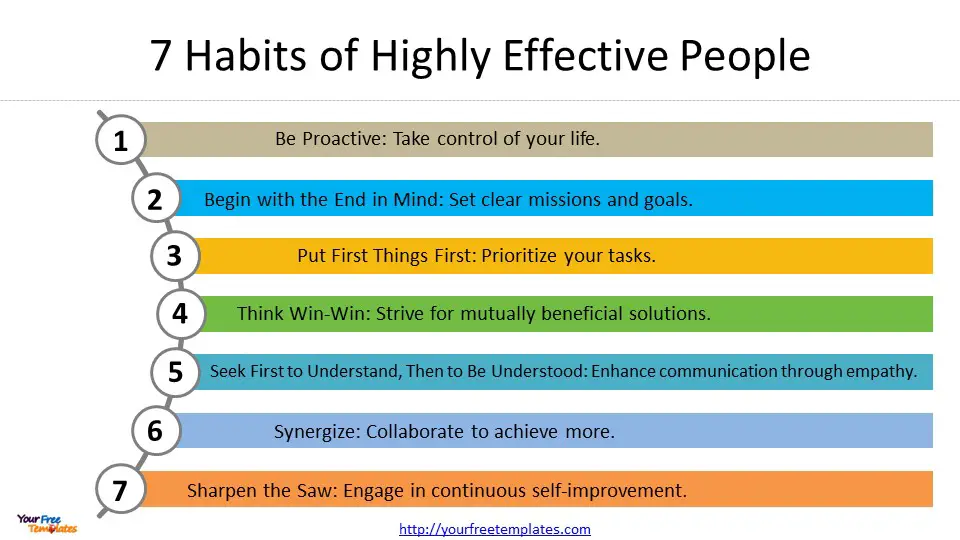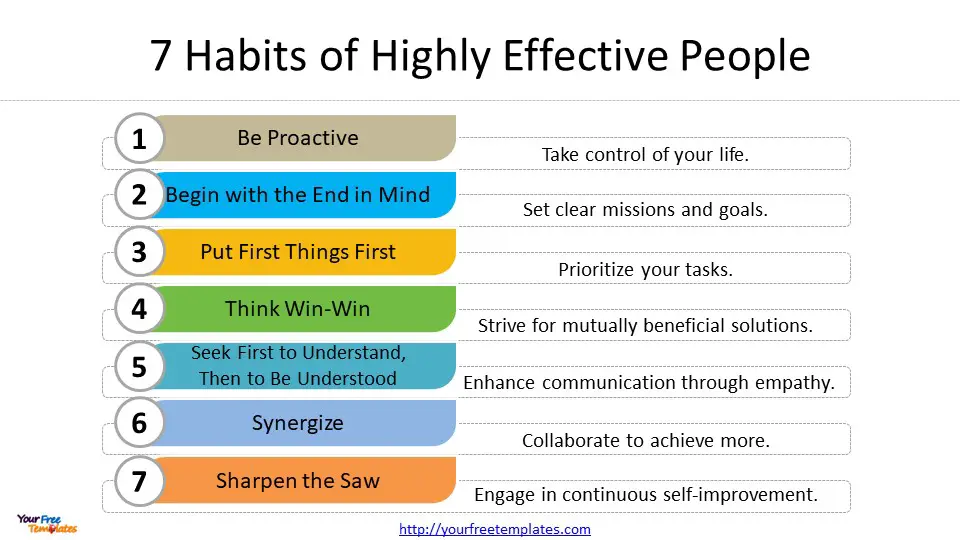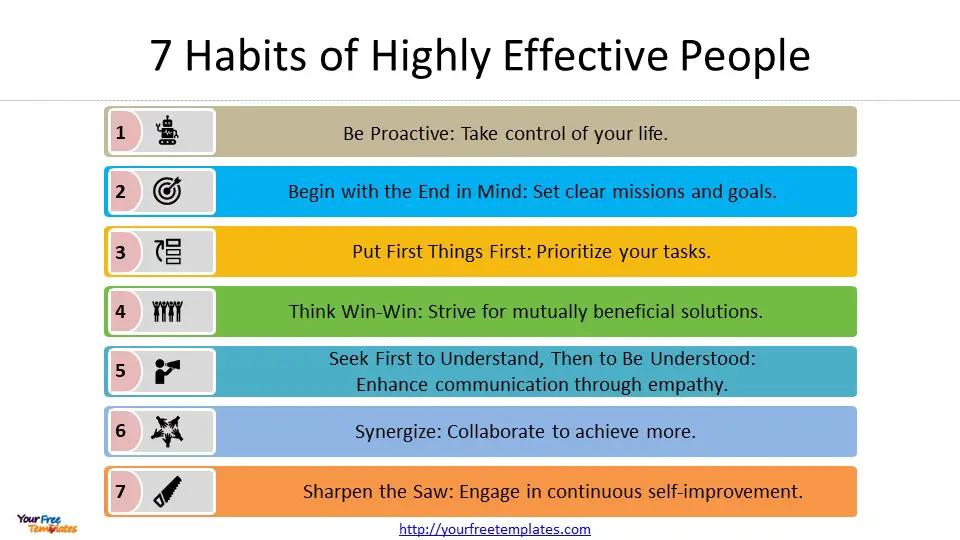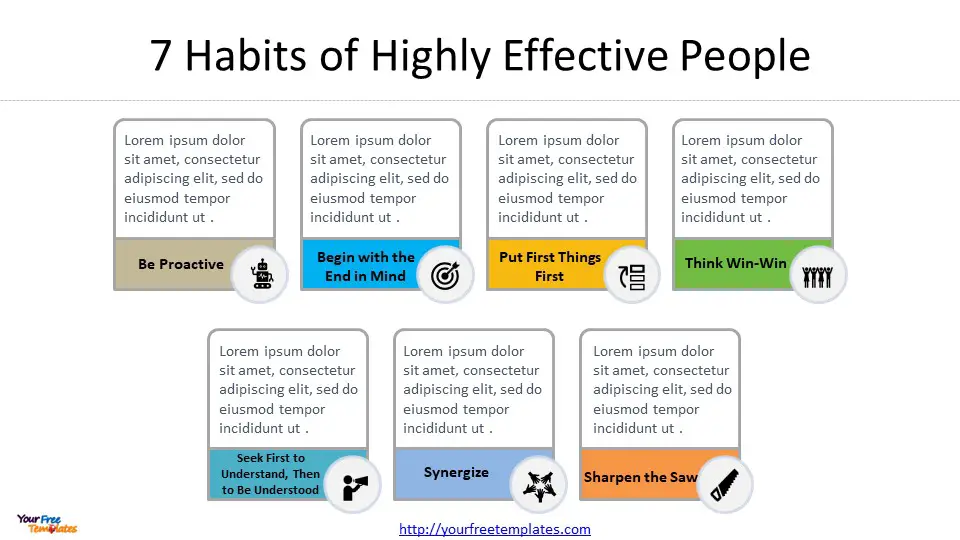In today’s fast-paced world, mastering effective habits has become crucial for personal and professional success. The 7 habits of highly effective people, introduced by Stephen Covey, offer a roadmap to achieve greater productivity and fulfillment. These principles have stood the test of time, providing individuals with tools to enhance their time management skills and foster continuous improvement in various aspects of life.
At the end of this post, you can download our 7 Habits of Highly Effective People PowerPoint template to fit your purpose. As the same diagram PowerPoint template series, you can also find our Six Thinking Hats, Pareto Chart, Occam’s Razor, Data Mining, marketing segment, Porter’s five forces, SWOT Analysis, GE Matrix, BCG Matrix, Artificial Intelligence, National Diamond and BlockChain PowerPoint templates.
This article delves into the core concepts of the seven habits of highly effective people, exploring how they can transform one’s approach to daily challenges and long-term goals. From being proactive to seeking mutual benefits in relationships, each habit plays a vital role in shaping a person’s effectiveness. By understanding and applying these principles, individuals can expand their circle of influence and unlock their full potential, leading to more meaningful and successful lives.
Be Proactive: Taking Control of Your Life

Being proactive is a fundamental principle that empowers individuals to take charge of their lives and shape their circumstances. It involves self-initiated, future-focused, and change-oriented behaviors 1. Rather than passively reacting to events, proactive individuals actively create opportunities and influence their environment.
Be Proactive Meaning
To be proactive means to take responsibility for one’s choices and behaviors, anticipating consequences before making decisions 2. It’s about focusing on what one can control and engaging in forward-thinking behavior 3. Proactive people recognize that they are “response-able,” choosing their actions, attitudes, and moods without blaming external factors 4.
Be Proactive Examples
- Preparing for Work: Arriving early to work demonstrates preparedness and values the job, impressing employers with reliability 5.
- Seeking Feedback: Proactively asking for feedback after completing a task shows a commitment to improvement and growth 5.
- Planning Ahead: Writing daily to-do lists helps organize thoughts and gain a sense of control over one’s life 5.
- Anticipating Challenges: Researching a company before a job interview allows for better preparation and increased confidence 5.
Be Proactive Benefits
Being proactive offers numerous advantages in personal and professional life:
- Enhanced Problem-Solving: Proactive individuals anticipate potential issues and develop solutions in advance 3.
- Improved Time Management: By prioritizing tasks and planning ahead, proactive people make better use of their time 4.
- Increased Influence: Focusing efforts on the Circle of Influence® allows individuals to make a more significant impact 4.
- Career Advancement: Employers value proactive employees for their initiative and ability to create opportunities 5.
- Reduced Stress: Taking control of situations and planning ahead can lead to decreased stress levels 1.
By adopting a proactive mindset, individuals can significantly enhance their effectiveness, resilience, and overall success in various aspects of life.
Begin with the End in Mind: Defining Your Goals

“Begin with the end in mind” is the second habit in Stephen Covey’s renowned book, “The 7 Habits of Highly Effective People” 6. This principle is based on the idea that all things are created twice: first in the mind, and then in the physical world 6. By envisioning the desired outcome before taking action, individuals can better align their efforts with their goals.
Begin with the End in Mind Meaning
This habit encourages individuals to start any task or project by considering the desired result or outcome 7. It involves creating a clear vision of what one wants to achieve and then working backward to plan the necessary steps 7. This approach helps people stay focused, motivated, and ensures that their efforts are directed toward specific goals.
Begin with the End in Mind Examples
- Steve Jobs: The co-founder of Apple applied this philosophy in product development, envisioning how products should function for end-users before bringing that vision to life 7.
- Oprah Winfrey: The media mogul attributes her success to visualizing her goals before taking action 7.
- John F. Kennedy: The former U.S. President set a clear goal of landing a man on the moon by the end of the 1960s, guiding his actions towards this specific objective 7.
Begin with the End in Mind Benefits
- Clarity and Focus: By starting with a clear understanding of the destination, individuals can better comprehend their current position and ensure their steps are in the right direction 8.
- Avoiding the “Activity Trap”: This habit prevents people from working hard at climbing the ladder of success, only to discover it’s leaning against the wrong wall 8.
- Personal Leadership: Developing a Personal Mission Statement allows individuals to become leaders of their own lives, creating their destiny and securing the future they envision 8.
- Goal-Oriented Mindset: This habit trains individuals to become more goal-oriented, creating a clear vision for themselves or their teams 6.
- Effective Planning: By envisioning the end result, people can determine whether the physical creation of the goal is possible, leading to more realistic and achievable objectives 6.
Put First Things First: Prioritizing What Matters

Put First Things First is the third habit in Stephen Covey’s renowned book, “The 7 Habits of Highly Effective People” 9. This habit focuses on effective time management, prioritization, and executing tasks based on importance rather than urgency 10.
Put First Things First Meaning
Putting first things first means organizing and executing around one’s most important priorities 9. It involves being driven by principles and values rather than external pressures or agendas 9. This habit emphasizes the importance of effective management in implementing leadership decisions on a day-to-day basis 9.
Put First Things First Examples
- Time Management Matrix: Covey introduces a matrix that categorizes tasks into four quadrants based on urgency and importance 9. The key is to focus on Quadrant II activities, which are important but not urgent 10.
- Prioritizing Essential Tasks: By identifying and prioritizing key tasks, individuals can accomplish their goals more easily and minimize the chances of missing important deadlines 11.
- Planning Ahead: Writing daily to-do lists helps organize thoughts and gain control over one’s schedule 11.
Put First Things First Benefits
- Improved Time Management: This habit helps individuals allocate more time to important tasks by starting the day with them 11.
- Enhanced Focus: By prioritizing essential tasks, people can direct their energy towards achieving primary goals before addressing less critical matters 11.
- Increased Productivity: Focusing on Quadrant II activities leads to better results and maintains a balance between productivity and production capacity 11.
- Stress Reduction: Proper prioritization and time management can lead to reduced stress levels and a higher quality of life 10.
- Personal Growth: Spending time in Quadrant II allows for learning new skills, building relationships, and implementing continuous improvement strategies 10.
Think Win-Win: Creating Mutual Benefits

Think Win-Win is a powerful paradigm shift that transforms professional relationships. It advocates for mutual benefit, where success is not a zero-sum game 12. This habit is based on an abundance mindset, believing there is enough for everybody 13. It involves seeking mutually beneficial outcomes in all human interactions, rather than having winners at the expense of others 14.
Think Win-Win Meaning
The Win-Win framework aims to generate mutually beneficial outcomes for all parties in a relationship, agreement, or partnership 13. It requires understanding the other party’s perspective, detaching the person from the problem, and focusing on interests rather than personalities 13. This approach reframes negotiations, viewing them as opportunities to find solutions that address all parties’ concerns 12.
Think Win-Win Examples
- Collaborative problem-solving: Two parties work together to find a solution that meets both their needs 15.
- Mutually beneficial contracts: A buyer and seller negotiate terms that satisfy both parties 15.
- Employee-employer relationships: Fair compensation and opportunities for growth in exchange for high-quality work 15.
- Joint ventures: Organizations combine resources to pursue mutually advantageous opportunities 15.
Think Win-Win Benefits
- Builds lasting relationships: Cultivates positive connections in professional contexts 12.
- Enhances trust: Improves relationships between parties, leading to more successful future negotiations 16.
- Promotes innovation: Encourages exploration of new ideas and solutions 16.
- Fosters effective communication: Encourages clear expression of needs and active listening 16.
- Encourages creativity: Stimulates the exploration of new ideas beneficial to all parties 16.

Conclusion
The 7 Habits of Highly Effective People offer a comprehensive framework to enhance personal and professional effectiveness. From being proactive to seeking mutual benefits, these principles have a profound impact on shaping one’s approach to life’s challenges and opportunities. By putting these habits into practice, individuals can boost their productivity, improve their relationships, and achieve their goals more efficiently.
To wrap up, mastering these habits is a journey of continuous growth and self-improvement. It requires commitment and consistent effort to apply these principles in daily life. As individuals internalize these habits, they’ll find themselves better equipped to handle life’s complexities, make meaningful contributions, and lead more fulfilling lives. The power of these habits lies not just in understanding them, but in their consistent application to transform one’s life for the better.
FAQs
What are the seven habits mentioned in “The 7 Habits of Highly Effective People”?
“The 7 Habits of Highly Effective People” by Stephen R. Covey outlines a roadmap for personal and professional excellence. It focuses on proactive behavior, setting priorities, effective communication, teamwork, and continuous personal development.
What central idea does “The 7 Habits of Highly Effective People” convey?
Stephen R. Covey’s central message in the book emphasizes the importance of self-care, staying physically active, nurturing emotional and mental health through continual learning, and fostering strong interpersonal relationships.
How can one incorporate the seven habits into their own life to enhance productivity?
To integrate the “7 Habits of Highly Effective People” into your life, especially to boost productivity, consider these steps:
- Be proactive in your actions.
- Always have a clear vision of your goals (Begin with the end in mind).
- Prioritize tasks effectively (Put first things first).
- Foster mutually beneficial relationships (Think Win-Win).
- Understand others before seeking to be understood.
- Leverage collective strengths (Synergy).
- Continually renew and improve yourself (Sharpen the saw).
What is a notable quote from “The 7 Habits of Highly Effective People”?
A famous quote from the book is: “It’s not logical; it’s psychological. Sow a thought, reap an action; sow an action, reap a habit; sow a habit, reap a character; sow a character, reap a destiny.” This emphasizes the profound impact of our thoughts and actions on our ultimate destiny.

Need premium maps, pls visit our map shop: https://editablemaps.com
Size:155K
Type: PPTX
7 Habits of Highly Effective People Template
Click the link to download it.
Aspect Ratio: Standard 4:3
Click the blue button to download it.
Download the 4:3 Template
Aspect Ratio: Widescreen 16:9
Click the green button to download it.
Download the 16:9 Template
References
[1] – https://clockify.me/blog/managing-time/be-proactive/
[2] – https://resources.finalsite.net/images/v1646248278/beaufortk12scus/h2eyeiipwrb8jv3xhkwj/The7Habits.pdf
[3] – https://www.discovery-adr.com/proactive-7-habits-highly-effective-people-explained/
[4] – https://www.franklincovey.com/the-7-habits/habit-1/
[5] – https://helpfulprofessor.com/proactive-examples/
[6] – https://asana.com/resources/begin-with-the-end-in-mind
[7] – https://jambarteambuilding.com/real-life-examples-of-begin-with-the-end-in-mind/
[8] – https://www.franklincovey-benelux.com/en/resources/habit-2-begin-with-the-end-in-mind/
[9] – https://www.franklincovey-benelux.com/en/resources/habit-3-put-first-things-first/
[10] – https://lighthousetechnologies.com/2020/09/28/put-first-things-first/
[11] – https://weekplan.net/habit-3-put-first-things-first/
[12] – https://lmwgroup.com/habits-of-highly-effective-people-think-win-win/
[13] – https://www.tutuwaahwoi.com/booknotes/book-notes-habit-4-think-win-win-from-the-7-habits-of-highly-effective-people-by-stephen-covey/
[14] – https://weekplan.net/habit-4-think-win-win/
[15] – https://www.quora.com/What-are-some-examples-of-win-win-situations
[16] – https://www.linkedin.com/pulse/how-win-win-approach-can-benefit-procurement-gaurav-narula














